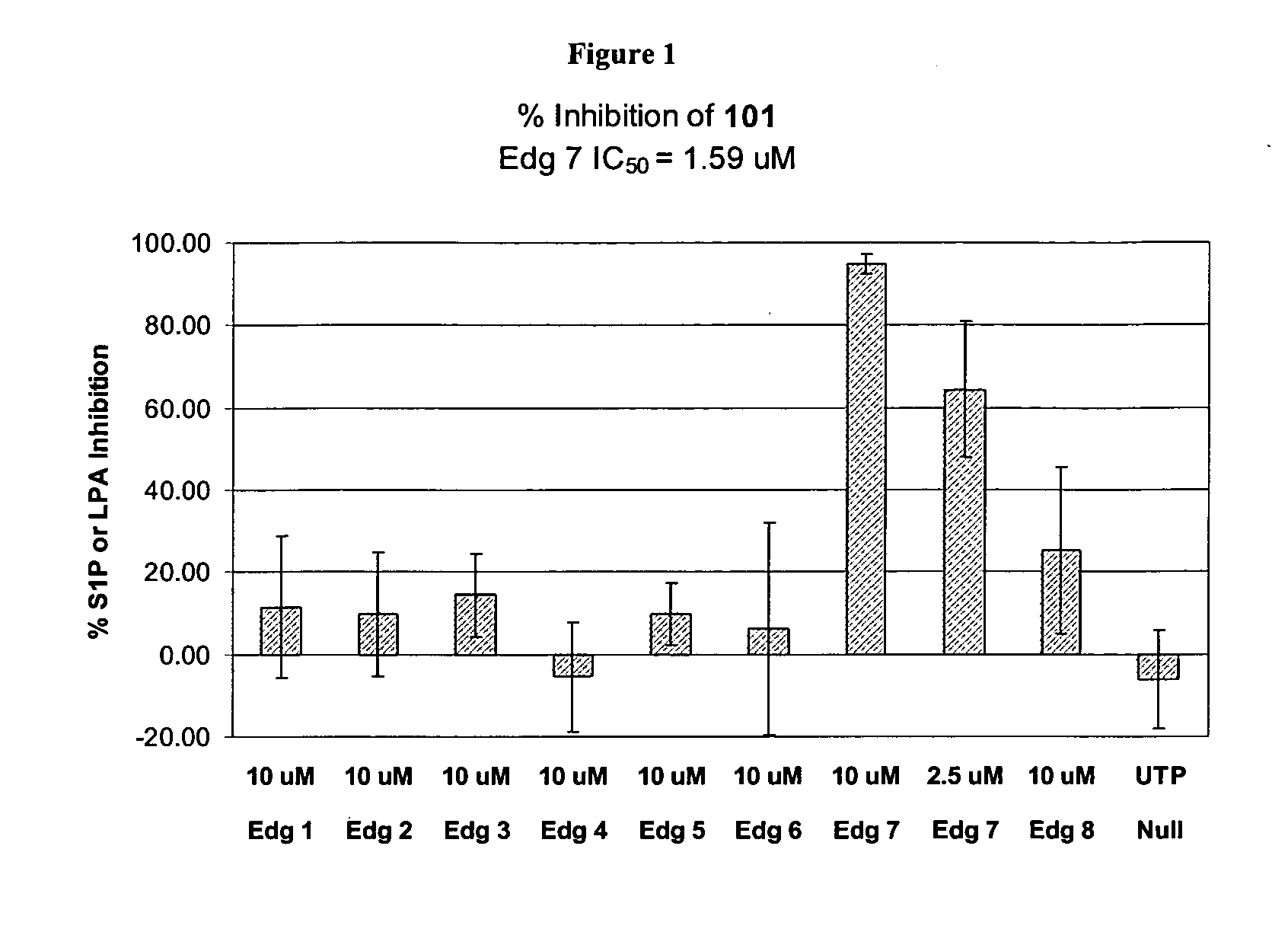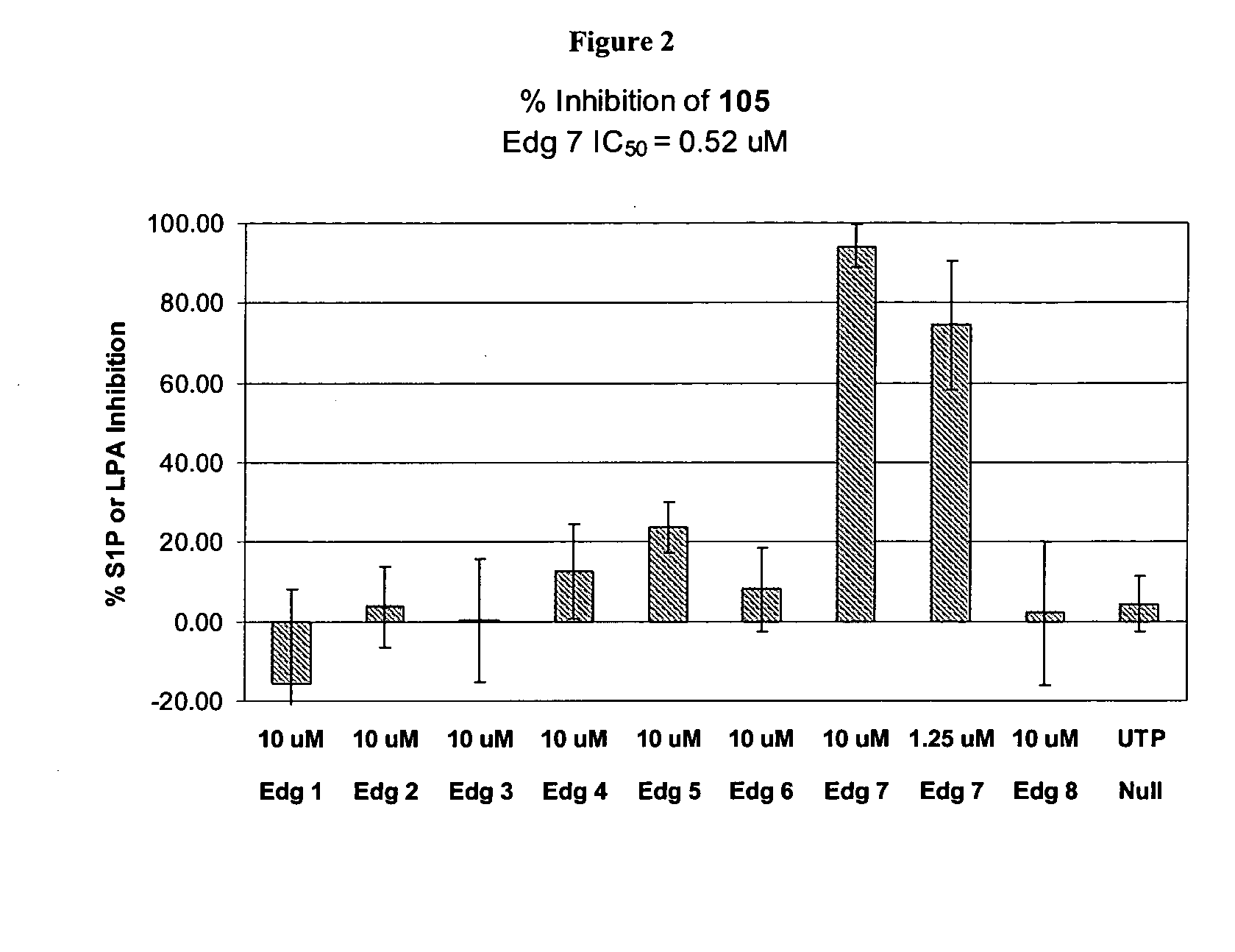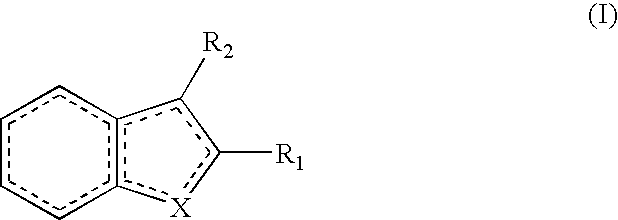Methods of treating conditions associated with an Edg-7 receptor
a technology of edg-7 receptor and biological activity, which is applied in the field of modulating biological activity mediated by the edg-7 receptor, can solve the problems of poor physicochemical properties, limited potential use of pharmaceutical agents of phospholipid compounds, and ineffective discrimination of phospholipid compounds, so as to achieve the effect of modulating the biological activity of the edg-7 receptor
- Summary
- Abstract
- Description
- Claims
- Application Information
AI Technical Summary
Benefits of technology
Problems solved by technology
Method used
Image
Examples
example 1
6.1. Example 1
Synthesis of Compound 101
[0275] 2-chlorobenzenesulfonyl isocyanate (0.13 mL, 0.89 mmol) was added to a solution of ethyl 2-amino-4, 5, 6, 7-tetrahydrobenzo[B]thiophene-3-carboxylate (0.20 g, 0.89 mmol) in benzene (2 mL) at room temperature. After 2.5 hours, the reaction mixture was filtered to provide 310 mg (79%) of 101 as a white solid.
[0276]1H NMR (300 MHz, CDCl3) δ: 11.68 (s, 1H), 8.33 (m, 1H), 7.92 (br s, 1H), 7.57 (m, 2H), 7.43 (m, 1H), 4.39 (m, 2H), 2.73 (m, 2H), 2.58 (m, 2H), 1.75 (m, 4H), 1.38 (m, 3H). CI-MS: m / z=443 [C18H19ClN2O5S2+H]. Melting Range: 222-225° C.
example 2
6.2. Example 2
Synthesis of Compound 129: 2,3-bis-(4-Methoxyphenyl) quinoxaline-6-carboxylic acid
[0277]
[0278] A mixture of 3,4-diaminobenzoic acid (0.153 g, 1.00 mmol), 4,4′-dimethoxybenzil (0.271 g, 1.00 mmol) and acetic acid (6 mL) was stirred at reflux for 12 h, cooled to room temperature and poured into water (75 mL). The resultant solid was taken up in aqueous sodium hydroxide (2M) and washed with dichloromethane; the aqueous layer was acidified and the resultant solid was recrystallized from methanol to afford 2,3-bis-(4-methoxyphenyl)quinoxaline-6-carboxylic acid (0.171 g, 44% yield) as a yellow solid: mp 284-285° C.; 1H NMR (500 MHz, Acetone-d6) 8.79 (s, 1H), 8.39 (d, 1H), 8.21 (d, 1H), 7.61 (d, 4H), 6.97 (d, 4H), 3.89 (s, 7H); ESI MS m / z 387 [C23H18N2O4+H]+.
example 3
6.3. Example 3
Synthesis of Compound 131
(a) 2,4-Diethyl-10,10-dioxo-10H-10□6-thioxanthen-9-one
[0279]
[0280] Hydrogen peroxide (3.0 mL, 29.0 mmol) was added 1 mL at a time to a refluxing solution of 2,4-diethyl-thioxanthen-9-one (0.504 g, 1.88 mmol) in acetic acid (˜10 mL) and allowed to stir for 2 h. The reaction was cooled to room temperature and allowed to stand 18 h. The reaction was filtered and the resulting yellow, highly viscous liquid was washed with dichloromethane and methanol, then reduced in vacuo. 2,4-Diethyl-10,10-dioxo-10H-10□6-thioxanthen-9-one (0.381 g, 67% yield) was obtained as a yellow solid after recrystallization from ethanol and was identified on the basis of NMR spectral analysis.
(b) 2,4-Diethyl-10,10-dioxo-10H-10□6-thioxanthen-9-one
[0281]
[0282] Zinc amalgam was formed via the addition of zinc (0.956 g, 14.6 mmol) to mercury(II) chloride (0.125 g, 0.46 mmol). To this mixture water (10 mL) was added slowly. Hydrochloric acid (0.25-0.50 mL) was added and the ...
PUM
| Property | Measurement | Unit |
|---|---|---|
| Mass | aaaaa | aaaaa |
| Molar density | aaaaa | aaaaa |
| Molar density | aaaaa | aaaaa |
Abstract
Description
Claims
Application Information
 Login to View More
Login to View More - R&D
- Intellectual Property
- Life Sciences
- Materials
- Tech Scout
- Unparalleled Data Quality
- Higher Quality Content
- 60% Fewer Hallucinations
Browse by: Latest US Patents, China's latest patents, Technical Efficacy Thesaurus, Application Domain, Technology Topic, Popular Technical Reports.
© 2025 PatSnap. All rights reserved.Legal|Privacy policy|Modern Slavery Act Transparency Statement|Sitemap|About US| Contact US: help@patsnap.com



